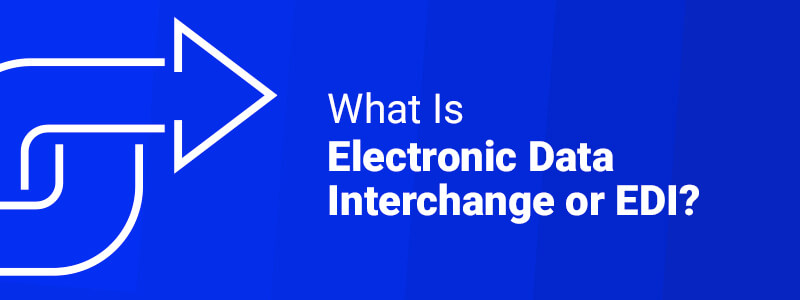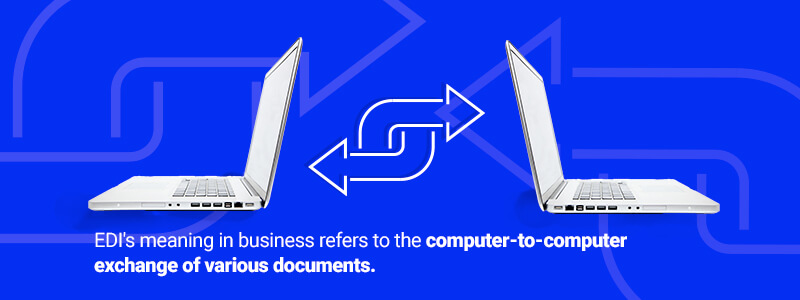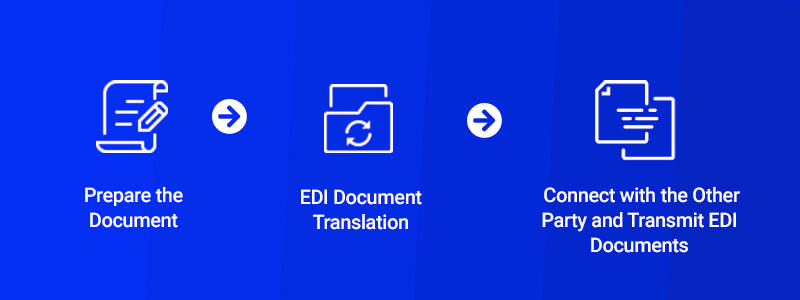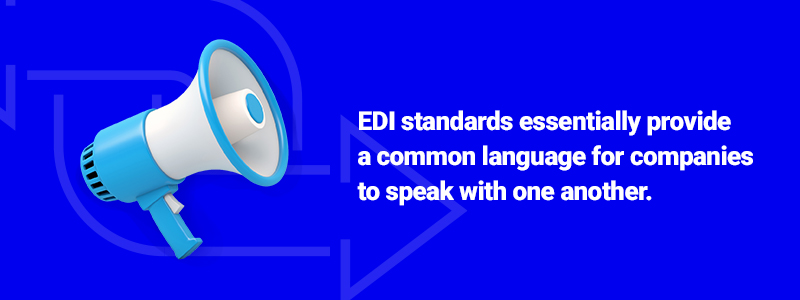
EDI, or electronic data interchange, is the leading way for B2B organizations to exchange information and facilitate transactions, regardless of the organization's size. EDI provides many benefits to companies looking for faster and more accurate ways to exchange documents with their clients and business partners. Since EDI offers so many advantages, companies may want to take the time to understand EDI and the ways it can help them become more profitable.
This guide covers what EDI is, the processes associated with it, the differences between traditional and EDI document exchange and the benefits of EDI, as well as how to implement EDI at your business and EDI standards.

What Is EDI in Business?
EDI (Electronic Data Interchange) is the computer-to-computer exchange of standardized documents between business partners. It automates the transmission of critical documents, such as invoices and purchase orders, through secure communication channels. This electronic process enhances efficiency by reducing manual errors and ensuring faster, more accurate transactions compared to traditional paper-based systems.
Since EDI relies on a computer-to-computer system, it reduces a company's reliance on email, fax and postal mail. Even though email is handled through an electronic system, people still have to write the emails and send them manually. EDI takes the human involvement out of the process entirely, transmitting data and information automatically through relevant software applications.
Typically, companies use EDI to send business documents to clients and other trading partners. Advanced ship notices, invoices, payment confirmations and purchase orders are some of the most common documents exchanged through EDI technology. You can also find other items sent via EDI, such as payment documents, shipping status documents, customs documents, inventory documents and bill of lading documents. Here are some of the top EDI documents you can send automatically:
- EDI 810 Invoice: Companies use EDI 810 to tell a client that an order has been shipped and request payment. The invoice will include payment terms, shipping details and goods provided. This electronic invoice removes the costs of paper invoices, such as labor expenses and material costs.
- EDI 850 Purchase Order: Buyers use EDI 850 to place orders, including information specifying order quantities, items, pricing and shipping details. Since this order is electronic, buyers can order more quickly and eliminate the chance of accidental duplicate orders.
- EDI 855 Purchase Order Acknowledgement: Sellers use EDI 855 to confirm a customer's order automatically, saving money and time spent on manually following up.
- EDI 856 Advance Shipping Notice: Companies use EDI 856 to tell customers they're shipping an order. The information about a shipment's delivery date and tracking number allows a customer to better prepare for deliveries and gives the shipper a faster method of alerting them.

What Is the EDI Process?
When you need to trade EDI documents, the party controlling the cash usually dictates the documents to be traded and those documents' specifications. The end-to-end flow in the trading of goods and services scenario, the most prolific usage, follows these steps:
- Purchaser's system generates a purchase order
- Purchaser's system translates the purchase order to their EDI specifications
- Purchaser disseminates the purchase order through a communication method that they support; they may offer more than one method. The most common methods are AS2, FTP, SFTP, HTTPS, and Value Added Network (VAN)
- Merchant utilizes in-house software or outsourced services to receive the EDI by connecting to the Purchaser's chosen communication method
- Merchant utilizes in-house software or outsourced translation services to present the purchase order in human-readable (pdf xls etc.) or machine-readable data format that the Merchant’s systems can process
- Typically, in this trading scenario, the Merchant fills the order and returns data that complies with the Purchaser’s specifications, such as an EDI invoice, reversing the flow laid out above.
Of course, there are many other uses and trading scenarios, including the energy and medical fields, to name a couple, but the key ingredients identified above are required. The documents and their purposes may differ. In the end, minimized data entry, speed of delivery, minimized errors, and standardized communication with a large community are realized through implementing EDI.
EDI Document Exchange vs. Traditional Document Exchange
EDI document exchange offers many advantages over traditional document exchange because the EDI process handles much of the exchange automatically. To understand how these methods of exchange differ, review the primary steps companies would have to take for a purchasing transaction via traditional or EDI document exchange:
Traditional Document Exchange for a Purchase Order
In a traditional document exchange for a purchase order, a buyer will review their inventory and decide they need to place an order, or they'll receive a notification telling them they should order relevant items. To create the purchase order, the buyer manually enters the data in a purchase system to generate the purchase order, mailing or emailing it to the vendor once complete.
If mailed, the purchase order can take days to arrive, and if emailed, the purchase order requires a representative to see the email and take action on it. Once received, the vendor manually enters the purchase order into their system. They then generate an invoice, sending a printed copy with the shipping order or a digital copy via email. Finally, the buyer has to handle the invoice manually, entering it into their accounts payable system.
EDI Document Exchange for a Purchase Order
As you can probably tell, a traditional document exchange can take a lot of time and has plenty of opportunities for human error. EDI document exchange is much more efficient and accurate. At the beginning of the process, a buyer's EDI-capable procurement system recognizes their inventory has hit a specified level. It then autogenerates a purchase order and sends it to a vendor. Almost instantly, the purchase order arrives in the vendor's EDI sales order system.
This system then automatically tells the vendor's shipping department to send the products to the buyer. After the specified products are available to ship, the shipping system then transmits an EDI-compliant shipping notice to the buyer's receiving departments. Finally, the vendor creates an EDI invoice, sending it to the buyer's accounts payable system. This entire, multi-step process can take only an hour, with completely accurate information transferred between parties.
The Features and Benefits of Using EDI
When a company employs EDI for its business operations, it can receive several benefits. Many businesses use EDI to cut down on paper costs, improve efficiency, increase their security and reduce errors. If you need to communicate with buyers and sellers, the advantages of EDI can help you significantly. For example, retailers with EDI technology can better communicate with suppliers to keep their stores well-stocked, while manufacturers can use EDI to process orders and ship products on time.
Here are more of EDI's benefits:
- Reduced errors: Errors can cost time and money as you look to fix the situation. When employees must manually enter data into order systems or enterprise resource planning programs, errors are almost inevitable. EDI solutions remove the threat of manual entry, automating key processes and ensuring accuracy.
- Greater speed and efficiency: When you make EDI integration a priority across your operations, you can see an increase and efficiency. EDI makes it so operations that used to take days or weeks take only minutes. Employees don't have to enter data, exchange data or process orders manually. Instead, EDI processes streamline your business operations by automating them.
- Less paper: Companies using EDI solutions reduce the costs related to purchasing paper and dedicating labor to handling it and storing it. Since data and information are exchanged electronically via EDI technology, companies can reduce their reliance on paper, saving them time and money and making their operations more environmentally friendly.
- Security: EDI is exceptionally secure, designed for only authorized users and often including extra security features, like audit trailing and archive tracking. Your company can use EDI with greater peace of mind, as you know you're sharing data as securely as possible.
- Increased profits: All companies want to raise their profits, and EDI allows them to do just that. When you use EDI to increase your operations' speed and efficiency, cut paper-related costs, reduce reliance on manual labor and reduce errors, your profit-margin will likely increase as a result.

What Are EDI Standards?
EDI standards refer to the specifications for the content and format of EDI business documents. These standards ensure EDI documents have data units in the right location and order. Any EDI transaction must follow the EDI standards defined for it. EDI standards developers craft standard formats for thousands of types of documents, such as invoices, purchase orders and payment confirmations.
Various regions and industries rely on specific kinds of EDI standards to facilitate communication. Companies in the United States use the American National Standards Institute/Accredited Standards Committee X12 (ANSI ASC X12) for document transmission, while international companies use EDI for Administration, Commerce, and Transport (EDIFACT) standards. There are also standards for particular industries, such as the Electronics Industry Data Exchange (EIDX), the Automotive Industry Action Group (AIAG) and the Textile/Apparel Manufacturing Communications (TAMCS).
Without these standards, communication between companies and trading partners would be less efficient and more confusing. EDI standards essentially provide a common language for companies to speak with one another, allowing them to communicate nearly instantaneously. Since businesses can use various EDI standards, they need to agree on the specific EDI standards and versions they'll use to communicate with one another.
EDI Implementation
EDI implementation involves a multi-step process that companies should follow for the best results in their operations. Here are the 10 steps:
- Organize a group to prepare for the implementation. This group often includes selecting a dedicated EDI team, a senior management sponsor, a steering committee and an EDI coordinator.
- Conduct a strategic review of applications likely to benefit from EDI, prioritizing which ones should receive EDI first.
- Administer an in-depth analysis, examing the costs of EDI, parts of your organization most ready for EDI and where EDI can deliver the most savings and promote profitability.
- Create an EDI solution designed for your company's needs using information from the strategic review and in-depth analysis.
- Choose a qualified EDI network provider to handle your company's needs, helping you set up and manage EDI solutions at your company.
- Prepare to integrate EDI into your business by ensuring your corporate applications have EDI systems.
- Analyze your data to understand how EDI integration will affect it and any new requirements from EDI standards or your business partners.
- Map your data to the required EDI standards using EDI translation software.
- Begin a pilot project to ensure your EDI solutions function properly. You'll choose specific business partners for this pilot program, using the results to refine your system.
- After the pilot project is complete, fully roll out EDI to the rest of your business partners.
Using ConnectPointz EDI Software
As a service of ACT Data Services, a leading EDI service bureau, ConnectPointz can set your company up with high-quality EDI software. We rely on ACT's experience serving thousands of clients with user-friendly EDI software to streamline our clients' operations and data exchange. Here are some of the top advantages of using ConnectPointz EDI software:
- Improved document exchange: One of the major benefits of using our EDI software is it allows you to trade electronic documents with any retail partner's system. By exchanging electronic documents via our EDI software, you can see faster and more accurate data transmission, helping you better serve clients and reduce costs.
- Greater end-to-end automation: Our EDI software features end-to-end automation, eliminating the need for manual input during many key processes. This automation reduces the need to allocate labor resources to these processes and keeps them more efficient.
- Enhanced in-line compliance validation: Since following EDI standards is essential, we ensure our software comes with in-line compliance validation. This compliance validation makes it so you always meet EDI standards, eliminating disruptions to your operations due to incorrect formatting or other forms of noncompliance.
- Consolidated portals: When you have to handle large quantities of data and communicate with many different partners, a central portal can be extremely helpful. We can provide companies with a single portal to handle data and meet EDI requirements, exemplified by our work with Bare Ground. This kind of portal consolidates data into one place and can automatically handle processes without any manual input required.
Learn More About EDI Software Solutions
With all of the benefits of using ConnectPointz EDI software solutions, you might be interested in learning more about how we can help improve your business processes. We're proud to offer exceptional pricing and employ staff ready to work with you to find the best solutions for your needs. Contact our team to find out more about the EDI solutions we can provide your company.









































